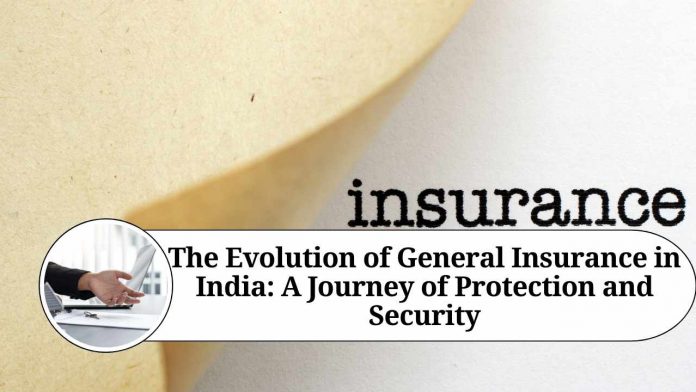Introduction
Insurance, a concept as old as human civilization itself, has been an integral part of societies across the globe. In India, the history of general insurance dates back several centuries, intertwining with the nation’s socio-economic development. This blog takes you on a fascinating journey through time, exploring the evolution of general insurance in India and its pivotal role in safeguarding the interests of individuals and businesses.
Ancient Roots:
The roots of insurance in India can be traced back to ancient times when trade and commerce flourished along the fertile banks of the Indus Valley and the Gangetic plains. Merchants engaged in overseas trade would form informal groups known as “yatras” to collectively pool resources and minimize risks. These early forms of mutual insurance provided a sense of security to traders in case of unforeseen events such as shipwrecks or theft.
Colonial Influence:
The advent of European colonial powers in India during the 17th century brought about significant changes in the insurance landscape. The East India Company, which held a monopoly on trade, introduced the concept of marine insurance to protect its commercial interests. Underwriters began to issue policies to safeguard against losses incurred during maritime voyages, paving the way for the formalization of insurance practices.
The Birth of General Insurance Companies:
The year 1850 marked a significant milestone in the history of general insurance in India. The Triton Insurance Company, based in Kolkata, became the first general insurance company to be established in the subcontinent. It offered policies covering a wide range of risks, including fire, marine, and accident insurance.
With the passing of the Indian Insurance Companies Act in 1928, the sector witnessed rapid growth. The Act provided a regulatory framework for insurance companies and established the need for solvency margins to protect policyholders. Several Indian and foreign companies entered the market, offering a diverse range of insurance products to cater to the evolving needs of individuals and businesses.
Nationalization and the Birth of LIC:
In 1956, the Indian government nationalized the insurance sector, leading to the creation of the Life Insurance Corporation of India (LIC). The move aimed to bring insurance coverage to the masses and protect their interests. LIC became the sole provider of life insurance, while general insurance continued to be provided by private and foreign players.
The Rise of Public Sector Insurance Companies:
In the 1970s, the Indian government took steps to further consolidate the insurance industry by nationalizing several general insurance companies. Companies such as National Insurance Company, New India Assurance Company, Oriental Insurance Company, and United India Insurance Company came under the control of the government. These public sector companies played a crucial role in extending insurance coverage across the country and promoting social welfare.
Liberalization and the Era of Privatization:
The year 2000 marked a turning point in the Indian insurance sector with the enactment of the Insurance Regulatory and Development Authority Act (IRDA). The Act opened doors for private players to enter the insurance market and compete with the public sector companies. This liberalization brought about increased competition, innovation, and a wider range of insurance products to cater to the diverse needs of customers.
Present Scenario and Future Prospects:
Today, the general insurance industry in India has experienced remarkable growth and transformation. With the advent of digital technology and data analytics, insurers are leveraging advanced tools to assess risks accurately, streamline operations, and offer personalized policies. The industry is witnessing the emergence of niche insurance products, such as cyber insurance, health insurance, and product liability insurance, to address the evolving risks in a rapidly changing world.
Conclusion
The journey of general insurance in India has traversed a long and eventful path, adapting to the changing socio-economic landscape of the nation. From ancient trade associations to national
Read more useful content:
Frequently Asked Questions (FAQs)
Q1: When did general insurance start in India?
A1: General insurance in India traces its roots back to the establishment of the Triton Insurance Company in 1850, which was the first general insurance company in the subcontinent.
Q2: How did the concept of general insurance evolve in India?
A2: The concept of general insurance in India evolved with the influence of European colonial powers. The East India Company introduced marine insurance to protect their commercial interests, and over time, the sector expanded to include other types of insurance, such as fire, accident, and liability insurance.
Q3: What led to the nationalization of the insurance sector in India?
A3: The nationalization of the insurance sector in India took place in 1956 as a result of the government’s aim to bring insurance coverage to the masses and protect the interests of policyholders. The nationalization led to the establishment of the Life Insurance Corporation of India (LIC) and the nationalization of general insurance companies in subsequent years.
Q4: How did the liberalization of the insurance sector impact general insurance in India?
A4: The liberalization of the insurance sector in India, initiated through the enactment of the Insurance Regulatory and Development Authority Act (IRDA) in 2000, allowed private players to enter the market and compete with the public sector companies. This led to increased competition, innovation, and a wider range of insurance products and services being offered to consumers.
Q5: What are some notable public sector general insurance companies in India?
A5: Some notable public sector general insurance companies in India include National Insurance Company Limited, New India Assurance Company Limited, Oriental Insurance Company Limited, and United India Insurance Company Limited. These companies were nationalized and played a significant role in expanding insurance coverage across the country.
Q6: How has technology influenced the general insurance industry in India?
A6: Technology has had a profound impact on the general insurance industry in India. Insurers are leveraging digital tools and data analytics to streamline operations, assess risks accurately, and offer personalized policies to customers. Additionally, the advent of online platforms and mobile applications has made insurance products more accessible to individuals and businesses.
Q7: What are some emerging insurance products in the Indian market?
A7: In the Indian market, some emerging insurance products include cyber insurance, health insurance, product liability insurance, and specialized policies for sectors such as agriculture and renewable energy. These products cater to the evolving risks and needs of individuals, businesses, and specific industries.
Q8: What does the future hold for general insurance in India?
A8: The future of general insurance in India looks promising. With advancements in technology, increased consumer awareness, and a focus on risk mitigation, the sector is expected to witness further growth and innovation. Insurers will continue to adapt to changing customer demands and provide comprehensive coverage for a wide range of risks.




















